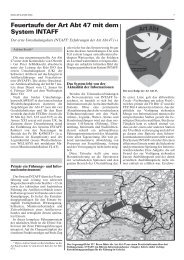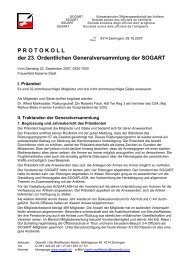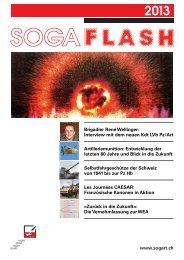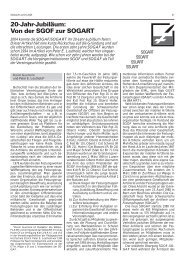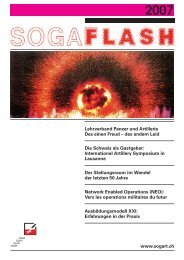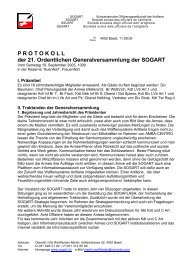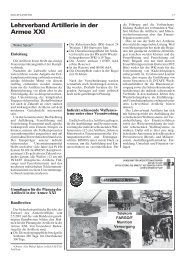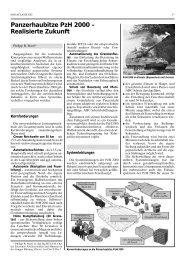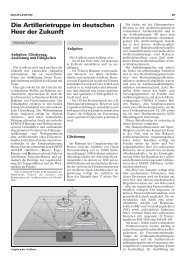Tiro Alto - SOGART SSOART SSUART
Tiro Alto - SOGART SSOART SSUART
Tiro Alto - SOGART SSOART SSUART
Erfolgreiche ePaper selbst erstellen
Machen Sie aus Ihren PDF Publikationen ein blätterbares Flipbook mit unserer einzigartigen Google optimierten e-Paper Software.
SOGAFLASH 2012 25<br />
cross-training, the EFSS battery in each<br />
battalion will be able to quickly transition<br />
to M777A2 operations if necessary without<br />
a long lag time. The battalion will also<br />
be better able to support task-organized<br />
MEU requirements since each Marine artilleryman<br />
will be knowledgeable on each<br />
system.<br />
Marines with Charlie Battery, 1st Battalion, 12th Marine Regiment, fire an M982 Excalibur round from an<br />
M777 howitzer during a fire support mission. (Photo by Cpl. Jeff Drew, U.S. Marine Corps)<br />
crous and maintaining them in such units<br />
off the battlefield is equally ill-advised.<br />
Furthermore, since HIMARS systems are<br />
best employed as sections, it only makes<br />
sense to disperse these sections as widely<br />
as possible throughout the force.<br />
The artillery community has gone in the<br />
opposite direction with the EFSS. Rather<br />
than integrating the mortar throughout<br />
the artillery community, it has been relegated<br />
to a sole battery in each regiment.<br />
This only ensures that most artillerymen<br />
will never get the chance to work or train<br />
with the system unless they are assigned<br />
to these few batteries. Once they are assigned<br />
to these batteries, they may bring<br />
with them no knowledge or experience<br />
with the system, but must be brought up<br />
to speed. For the EFSS system to reach<br />
its full potential and to be fully integrated<br />
with the other two legs of the triad of<br />
Fires, we must begin to build institutional<br />
knowledge and experience with the system.<br />
This can never be achieved under the<br />
current system.<br />
Since artillery will continue to fight and<br />
train as battalions, the ideal way to utilize<br />
the ‘triad of Fires’ is to integrate all three<br />
weapon systems into the Marine artillery<br />
battalion. The artillery battalion of the future<br />
should consist of two 6-gun M777A2<br />
batteries, one 8-gun EFSS battery, and a<br />
Headquarters and Service Battery that<br />
includes a HIMARS platoon (one 2-system<br />
section and its support). This heterogeneous<br />
battalion offers the regimental<br />
combat team (RCT) commander the complete<br />
range of capabilities that Marine<br />
artillery can provide and the artillery battalion<br />
commander a wide range of options<br />
to meet the commander’s intent. During<br />
low- intensity, distributed operations, the<br />
M777A2 and EFSS batteries can provide<br />
wide-ranging indirect fire coverage while<br />
adding the long- range, all-weather, precision<br />
strike capability of HIMARS. The<br />
EFSS battery allows the RCT commander<br />
to weigh his main effort with a more responsive<br />
weapon system with a higher<br />
rate of fire. During conventional operations,<br />
this method can yield the same ability<br />
to mass Fires on a decisive point as the<br />
classic artillery battalion while giving the<br />
RCT commander the ability to affect the<br />
enemy in the deep battle space.<br />
This organization has additional benefits<br />
while not deployed. It would give the<br />
artillery battalion commander the ability<br />
to cross train his battalion on each weapon<br />
system. Currently, artillerymen will utilize<br />
one weapon system for a three-year<br />
fleet tour, serve on a B billet, and then return<br />
to the fleet, possibly utilizing a vastly<br />
different weapon system. This will lead to<br />
gaps of six to nine years or more where artillerymen<br />
do not train on two out of three<br />
systems. This is obviously unsustainable.<br />
The only solution is to maintain those<br />
skills through cross training and a battalion<br />
with access to all three systems is<br />
the ideal organization to accomplish that<br />
goal. Additionally, because of this skill<br />
Decentralized fire direction<br />
Bedard also wrote, “As we develop and<br />
field more digital communications systems<br />
for the artillery, to include Advanced<br />
Field Artillery Tactical Data System (AF-<br />
ATDS), the personnel structure and training<br />
must support its implementation.”<br />
The other major change to artillery that<br />
must be embraced is decentralized fire direction.<br />
Batteries that have experimented<br />
with EBO or conducted split battery operations<br />
in Afghanistan have strained to<br />
conduct these operations with classic,<br />
centralized fire direction that the Marine<br />
Corps has utilized for years. While automated<br />
fire direction has been a reality<br />
since 1944, this capability has never had<br />
an evolutionary impact on artillery structure<br />
or employment. This lack of evolution<br />
was partly due to the limitations of<br />
early automated fire direction systems,<br />
but technology has now advanced to the<br />
point where evolution is possible. The decentralized<br />
nature of modern<br />
infantry combat necessitates the parallel<br />
decentralization of fire support and<br />
thus, decentralized fire direction. In situations<br />
where counter-battery fire is a concern,<br />
centralized fire direction is fraught<br />
with liability. Decentralized fire direction<br />
would also greatly enhance Marine artillery<br />
when conducting operations such as<br />
a ‘jumping barrage.’ With the right software,<br />
an off-the-shelf iPod Touch or other<br />
similar technology can provide automated<br />
fire direction in the palm of your hand.<br />
The inherent communications capability<br />
enables these devices to communicate<br />
with each other. There is no longer a reason<br />
to continue concentrating fire direction<br />
at the battery level in a pair of ancient<br />
desktop computers. Many will find the<br />
elimination of battery fire direction center<br />
(FDC) to be uncomfortable, but it is<br />
not without precedence. The German 18th<br />
Artillery Division was able to mass the<br />
Fires of its batteries using an experimental<br />
fire direction battery at the division level<br />
in 1943, utilizing a primitive electronic<br />
computer linked to teletype machines.<br />
Raytheon’s Centaur Handheld Fire Direction<br />
System, now outdated by civilian




